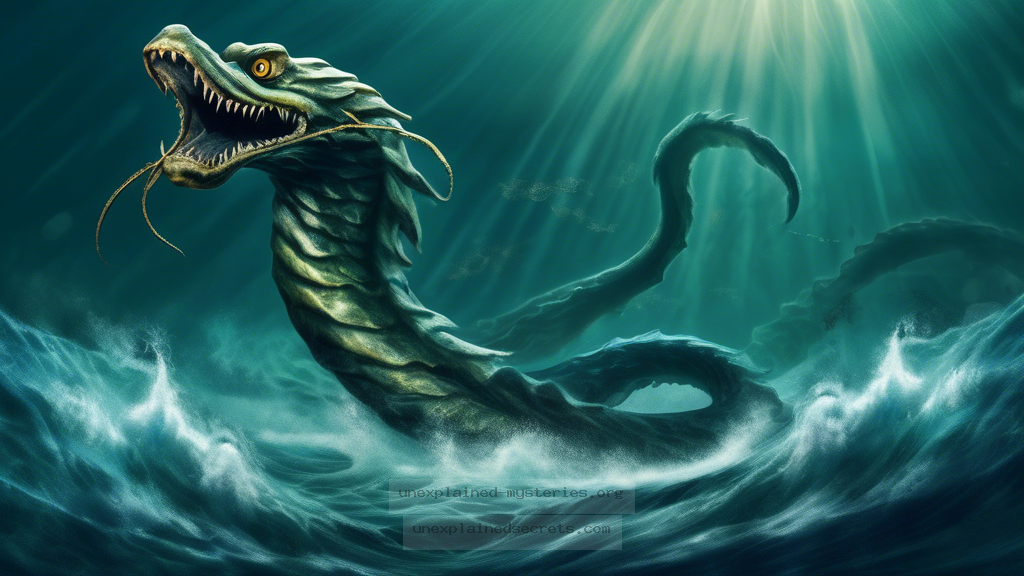What Secrets Lurk Beneath the Waves: The Mystery of the Great Sea Serpent?
What Secrets Lurk Beneath the Waves: The Mystery of the Great Sea Serpent?
The Great Sea Serpent has haunted the imaginations of mariners and cryptozoologists alike for centuries. Tales of this enigmatic creature have been passed down through generations, often described as long, sinuous, and terrifying. But what exactly is the Great Sea Serpent? Are these sightings mere folklore, or is there a possibility that something truly monstrous roams the depths of our oceans? This question matters not only for its historical context but also for its implications on our understanding of unexplored marine life. In this post, we will delve into the various aspects of the Great Sea Serpent phenomenon, exploring historical accounts, theories, and the ongoing mystery that continues to baffle experts and enthusiasts alike.
Historical Context: The Origins of the Sea Serpent Legend
The legend of the Great Sea Serpent can be traced back to ancient maritime cultures. The earliest recorded sightings of sea serpents can be found in texts from the Norse sagas, where they were often depicted as formidable creatures that could capsize ships. One of the most notable early accounts comes from the 13th century, when the Icelandic explorer and historian, Snorri Sturluson, described a creature called the “serpent of the sea,” which was said to be responsible for numerous shipwrecks.
As European exploration expanded in the 16th and 17th centuries, reports of sea serpent sightings increased dramatically. Sailors returning from distant waters told tales of enormous, snake-like creatures, often accompanied by descriptions of their ferocious behavior. In 1848, the famed naturalist and explorer, Sir James Clark Ross, reported seeing a sea serpent off the coast of the Antarctic, further fueling the legend and prompting widespread interest in cryptozoology.
Core Concepts: What Exactly Is the Great Sea Serpent?
The Great Sea Serpent is often portrayed as a colossal marine creature, sometimes likened to a giant snake or a prehistoric reptile. While many of these accounts are anecdotal, they often share similar characteristics: a long, undulating body, a series of humps breaking the water’s surface, and the ability to move swiftly through the ocean. Some researchers speculate that these descriptions may be rooted in sightings of known marine animals, such as the oarfish, which can grow up to 36 feet long and resembles the serpent-like descriptions attributed to the Great Sea Serpent.
Another theory posits that the sea serpent could be a surviving species of a long-extinct marine reptile, such as the plesiosaur. Fossil evidence indicates that such creatures once roamed the oceans, leaving some to wonder if isolated populations could still exist in unexplored depths. However, this remains speculative, as no definitive evidence has yet been uncovered.
Practical Implications: Evidence and Sightings
Despite the lack of concrete scientific evidence supporting the existence of the Great Sea Serpent, numerous sightings have been reported over the years, particularly in coastal regions known for their rich folklore. In 1878, a well-documented sighting occurred off the coast of Norway, where a group of fishermen claimed to have encountered a massive creature with a long neck and a substantial body. This sighting was corroborated by multiple witnesses and even attracted the attention of local newspapers.
In more recent times, the advent of technology has allowed researchers to investigate these claims further. The use of underwater drones and sonar has led to the discovery of previously unknown marine species, yet no definitive proof of the Great Sea Serpent has been found. Nonetheless, the ongoing interest in these creatures continues to inspire expeditions and research into unexplored marine territories.
Alternative Perspectives: Skepticism and Explanations
While many enthusiasts believe in the existence of the Great Sea Serpent, skeptics argue that most sightings can be attributed to misidentified marine animals or natural phenomena. For example, large schools of fish, floating debris, or even optical illusions can create the appearance of a long, serpentine creature. In addition, the psychological phenomenon known as pareidolia—where the brain recognizes patterns, such as faces or animals, in random stimuli—can lead to false sightings.
One significant skeptic, Dr. Karl P. N. Kauffman, a marine biologist, suggests that the allure of the sea serpent stems from a deep-rooted human fascination with the unknown. He argues that the ocean’s vastness makes it a fertile ground for myths and legends, often leading to exaggerated accounts of encounters with sea monsters. This perspective invites us to consider the role of cultural storytelling in shaping our understanding of the natural world.
Common Misconceptions and Clarifications
One common misconception surrounding the Great Sea Serpent is that all reported sightings are credible and scientifically valid. In reality, many accounts are anecdotal and lack substantial evidence. Additionally, the term “sea serpent” is often used interchangeably with other cryptids, such as the Loch Ness Monster or the Kraken, leading to confusion about what constitutes a true sea serpent.
Notable Fact: The term “Kraken” is often used to describe a legendary sea monster that is depicted as a giant octopus or squid, distinct from the serpentine descriptions of the Great Sea Serpent.
Another misconception is that the Great Sea Serpent is a modern invention. In reality, accounts of such creatures date back centuries, and the concept has evolved over time. While modern sightings may draw inspiration from ancient tales, they often reflect contemporary fears and curiosities related to the unknown.
Best Practices for Investigation or Study
For those interested in investigating the Great Sea Serpent phenomenon, it is essential to approach the subject with a critical mindset. Here are some best practices for potential researchers:
- Document Sightings: Keep a detailed log of any reported sightings, including dates, locations, and witness accounts. This can help identify patterns and commonalities.
- Utilize Technology: Employ underwater drones and sonar technology to explore potential habitats for sea serpents, focusing on regions known for frequent sightings.
- Engage with Local Folklore: Speak with local communities to gather stories and historical accounts. Understanding cultural context can provide valuable insights into the legend.
- Collaborate with Experts: Work with marine biologists, ecologists, and cryptozoologists to analyze evidence and develop a comprehensive investigation approach.
- Stay Skeptical: Approach the subject with an open mind, but maintain a skeptical perspective. Distinguish between credible evidence and mere anecdote.
Future Developments: Ongoing Research and Expeditions
The search for the Great Sea Serpent is far from over. As technology advances, researchers are continuously exploring the depths of the ocean, which remain largely uncharted. The use of autonomous underwater vehicles (AUVs) and advanced sonar systems has opened new possibilities for discovering unknown marine life.
Additionally, the growing interest in ocean conservation has led to increased funding for marine research, which may eventually lead to new discoveries that could shed light on the existence of cryptids like the Great Sea Serpent. Ongoing expeditions to areas with high historical sighting rates, such as the waters off Norway and the Bermuda Triangle, are also likely to yield intriguing findings.
Future Insight: The ocean is one of the least explored environments on Earth, covering over 70% of the planet’s surface. It’s possible that undiscovered species, including giant or unusual marine creatures, could still exist.
Conclusion: Decoding the Mystery of the Great Sea Serpent
The Great Sea Serpent remains one of the most captivating mysteries in the realm of cryptozoology. While many sightings have been dismissed as folklore or misidentifications, the enduring allure of this creature continues to inspire fascination and inquiry. By examining historical accounts, exploring core concepts, and considering alternative perspectives, we gain a deeper understanding of both the sea serpent legend and the human desire to uncover the unknown.
As we delve into the mysteries of our oceans, we must remain open to the possibility that some legends may contain a kernel of truth. The story of the Great Sea Serpent serves as a reminder of the vastness of the unknown, encouraging us to explore, investigate, and perhaps one day, unveil the secrets that lie beneath the waves.
Other Articles
Can Telepathy Be Scientifically Proven Through Laboratory Evidence?
Recent Posts
- What Happened to Flight MH370? The Conspiracy Theories That Still Haunt Us
- What Secrets Lurk Within the Walls of the Infamous Trans-Allegheny Lunatic Asylum?
- What Evidence Supports the Existence of Bigfoot in the Pacific Northwest?
- What Happened to the Indus Valley Civilization? Unraveling the Mysteries of Ancient Urban Life
- Can Telepathy Be Scientifically Proven Through Laboratory Evidence?







